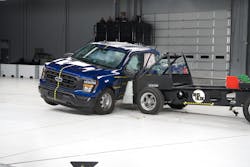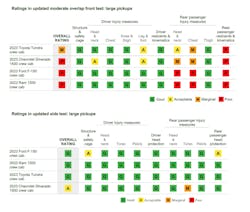A safety test of four crew-cab pickup trucks revealed that back seat passengers may be at higher risk of fatality than passengers in the front seat, according to the Insurance Institute for Highway Safety (IIHS).
IIHS has updated both its side crash test and its front test. Its new modified overlap front crash test emphasized back seat safety. IIHS recently ran these two test on four large 2023 pickups: a Ram 1500 crew cab, Ford F-150 crew cab, Toyota Tundra crew cab, and Chevrolet Silverado 1500 crew cab. Although the four offer strong protection in side crashes, they fall short when it comes to protecting passengers in the back seat, according to IIHS.
The Ram 1500 crew cab, Ford F-150 crew cab, and Toyota Tundra crew cab earn “good” ratings; the Chevrolet Silverado 1500 crew cab is rated “acceptable.” In the updated moderate overlap front crash test, however, only the Tundra manages a marginal IIHS rating. The F-150, Ram 1500, and Silverado are rated “poor.”
“Like most other vehicle classes, large pickups don’t perform as well in the new moderate overlap evaluation as they do in the updated side test, which is now a requirement for our Top Safety Pick awards,” said David Harkey, president, in a statement.
Read also: What's inside the Ford Lightning electric pickup truck?
IIHS launched the updated moderate overlap front test last year after research showed that in newer vehicles the risk of a fatal injury is now higher for belted occupants in the second row than for those in front. This is not because the second row has become less safe. Rather, the front seat has become safer because of improved airbags and advanced seat belts that are rarely available in back.
How safety is tested for the back seat
In the updated test, a second dummy is positioned in the second row behind the driver. The driver dummy is the size of an average adult man. The rear dummy is the size of a small woman or 12-year-old child. IIHS researchers also developed new metrics that focus on the injuries most frequently seen in back seat passengers.
For a vehicle to earn a “good” rating from IIHS, there cannot be an excessive risk of injury to the head, neck, chest, or thigh, as recorded by the second-row dummy. The dummy should remain correctly positioned during the crash without “submarining,” or sliding forward beneath the lap belt, which increases the risk of abdominal injuries. The head should also remain a safe distance from the front seat back and the rest of the vehicle interior, and the shoulder belt should remain on the shoulder, where it is most effective. A pressure sensor on the rear dummy’s torso is used to check the shoulder belt position during the crash.
As in the original test, the structure of the occupant compartment must maintain adequate survival space for the driver, and measurements taken from the driver dummy shouldn’t show an excessive risk of injuries.
Read also: ICE dominates pickups, but electrics proliferate
All four pickups provided good protection in the front seat. But the restraint systems in the rear were inadequate.
“Submarining was a problem for all four pickups, and belt forces were too high in all but the Tundra,” Harkey said.
Measurements taken from the rear dummy indicated that chest injuries and head or neck injuries would be likely in the F-150 and Ram 1500. The risk of those injuries was somewhat lower but still excessive in the Silverado. For the Tundra, the risk of chest injuries was also too high due to poor belt positioning, but the risk of head or neck injuries was only slightly elevated.
The updated side test was introduced to address higher-speed crashes that are still causing fatalities, even in vehicles that excelled in the original evaluation. Like its predecessor, the updated test uses two dummies, a driver, and a rear passenger. The new test uses a heavier barrier traveling at a higher speed to simulate the striking vehicle. The updated test replaced the original in the criteria for the Top Safety Pick awards in 2023.
In this test, the good-rated F-150, Ram 1500, and Tundra provided solid protection in front and back, though the occupant compartment of the F-150 was compromised slightly by the impact. There was an elevated risk of chest injury to the rear passenger in the acceptable-rated Silverado.
About the Author
Rod Sutton
Sutton has served as the editorial lead of Construction Equipment magazine and ConstructionEquipment.com since 2001.
Our mission is to help managers of heavy equipment and trucks to improve their performance in acquiring and managing their fleets. One way we do that is with our Executive Institute, where experts share information and ideas that will enable equipment managers to accurately manage equipment costs so that they can deliver the optimum financial benefits to their organizations.
We also have a laser focus on product development, performance, and technology; as well as equipment acquisition, disposal, and maintenance. Our exclusive Field Tests take earthmoving equipment and truck into the field for professional evaluations.
Check out our free newsletters to see the latest content.
You can find Sutton on LinkedIn.


